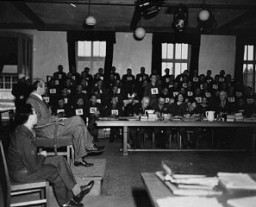You searched for: used交易程序後臺源碼【tg���������@ek7676】平台包网搭建usd交易程序後臺源碼【tg���������@ek7676】平台包网搭建ivkcss1pgu
<< Previous | Displaying results 251-275 of 1782 for "used交易程序後臺源碼【tg���������@ek7676】平台包网搭建usd交易程序後臺源碼【tg���������@ek7676】平台包网搭建ivkcss1pgu" | Next >>
-
Insignia of the 90th Infantry Division
PhotoInsignia of the 90th Infantry Division. Called the "Tough Ombres," the 90th Infantry Division was raised from draftees from the states of Texas and Oklahoma during World War I. The divisional insignia incorporates the letters "T" and "O" to symbolize both states. These letters later yielded the nickname "Tough Ombres," symbolizing the esprit de corps of the unit. The 90th was also sometimes called the "Alamo" division during World War II.

-
Insignia of the 83rd Infantry Division
PhotoInsignia of the 83rd Infantry Division. The 83rd Infantry Division received its nickname, the "Thunderbolt" division, after a division-wide contest for a new nickname held in early 1945. The earlier nickname, "Ohio," was based on the division's insignia (which includes the name "Ohio," where the division was raised during World War I). A new nickname was desired to represent the nationwide origins of the division's personnel during World War II.
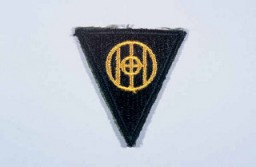
-
Insignia of the 95th Infantry Division
PhotoInsignia of the 95th Infantry Division. The 95th Infantry Division, the "Victory" division, gained its nickname from the divisional insignia approved in 1942: the arabic numeral "9" combined with the roman numeral "V" to represent "95." The "V" led to the nickname, since the letter "V" was universally recognized as an Allied symbol for resistance and victory over the Axis during World War II.
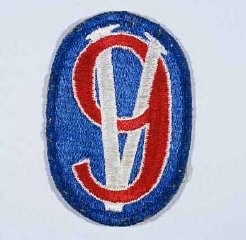
-
Insignia of the 8th Armored Division
PhotoInsignia of the 8th Armored Division. The nickname of the 8th Armored Division, the "Thundering Herd," was coined before the division went to Europe in late 1944. It was also known as the "Iron Snake" late in the war, after a correspondent for Newsweek likened the 8th to a "great ironclad snake" as it crossed the Rhine River in late March 1945.
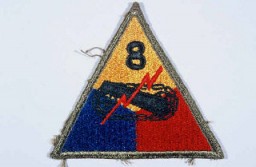
-
Insignia of the 8th Infantry Division
PhotoInsignia of the 8th Infantry Division. The 8th Infantry Division was known as both the "Golden Arrow" and "Pathfinder" division during World War II. Both nicknames originated from the division's insignia, which includes a gold arrow to represent the nineteenth century explorer of California, John Fremont. The division was formed in California in 1918.

-
Insignia of the 101st Airborne Division
PhotoInsignia of the 101st Airborne Division. The nickname of the 101st Airborne Division, "Screaming Eagles," originates from the division's insignia, a bald eagle on a black shield. "Old Abe" was the eagle mascot of a Wisconsin regiment during the Civil War. The 101st was formed as a reserve unit in Wisconsin shortly after World War I and included "Old Abe" as part of the division's insignia.
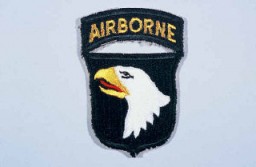
-
Insignia of the 103rd Infantry Division
PhotoInsignia of the 103rd Infantry Division. The 103rd Infantry Division, the "Cactus" division, is so called after the 103rd's shoulder patch, a cactus in a gold circle. The cactus is representative of the states whose troops formed the unit in the early 1920s: Arizona, Colorado, and New Mexico.
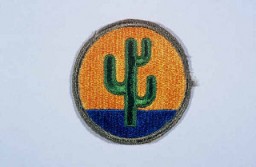
-
Insignia of the 63rd Infantry Division
PhotoInsignia of the 63rd Infantry Division. The 63rd Infantry Division was nicknamed the "Blood and Fire" division soon after its formation in the spring of 1943. The nickname commemorates British prime minister Winston Churchill's statement at the Casablanca Conference in January 1943 that "the enemy would bleed and burn in expiation of their crimes against humanity." The divisional insignia illustrates the nickname.
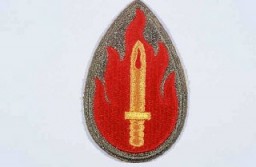
-
Insignia of the 42nd Infantry Division
PhotoInsignia of the 42nd Infantry Division. The nickname of the 42nd Infantry Division, the "Rainbow" division, reflects the composition of the division during World War I. The division was drawn from the National Guards of 26 states and the District of Columbia. It represented a cross section of the American people, as the rainbow represents a cross section of colors.

-
Insignia of the 36th Infantry Division
PhotoInsignia of the 36th Infantry Division. The 36th Infantry Division, the "Texas" division, was raised from National Guard units from Texas and Oklahoma during World War I. The "T" in the division's insignia represents Texas, the arrowhead Oklahoma. The division was also sometimes called the "Lone Star" division, again symbolizing its Texas roots.
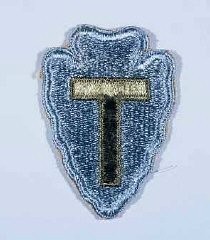
-
Insignia of the 29th Infantry Division
PhotoInsignia of the 29th Infantry Division. "Blue and Gray" was coined as the nickname of the 29th Infantry Division by the division's commander during World War I. The name commemorates the lineage of the mid-Atlantic states' National Guard units that formed the division, many with service on both sides during the Civil War.
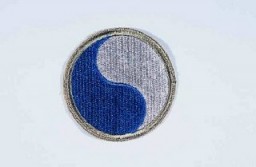
-
Death march victims
PhotoAn American soldier looks at the corpses of Polish, Russian, and Hungarian Jews found in the woods near Neunburg vorm Wald. The victims were prisoners from Flossenbürg who were shot near Neunburg while on a death march. Germany, April 29, 1945.
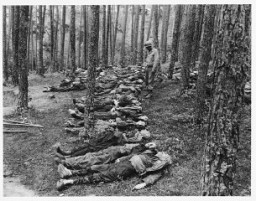
-
Insignia of the 89th Infantry Division
PhotoInsignia of the 89th Infantry Division. The 89th Infantry Division's nickname, the "Rolling W," is based on the division's insignia. Created during World War I, this insignia utilized a letter "M" inside a wheel. When the wheel turns, the "M" becomes a "W." The letters "MW" signify the mid-west origin of the troops who formed the 89th during World War I. The division was also known as the "Middle West" division, another variation on its origin.

-
Insignia of the 99th Infantry Division
PhotoInsignia of the 99th Infantry Division. The 99th Infantry Division, the "Checkerboard" division, gained its nickname from the division's insignia. The insignia was devised upon the 99th's formation in 1942, when the division was headquartered in the city of Pittsburgh. The blue and white checkerboard in the division's insignia is taken from the coat of arms of William Pitt, for whom Pittsburgh is named. The division was also known as the "Battle Babies" during 1945, a sobriquet coined by a United Press…
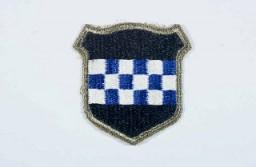
-
Funeral for victims of Wöbbelin
PhotoAfter the liberation of the Wöbbelin camp, US troops forced the townspeople of Ludwigslust to bury the bodies of prisoners killed in the camp. This photo shows US troops assembled at the mass funeral in Ludwigslust. Germany, May 7, 1945.
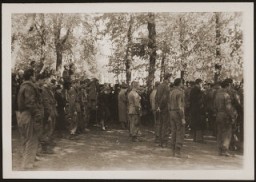
-
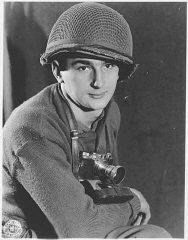
-
Providing aid to refugees
PhotoUS Army and Joint Distribution Committee (JDC) representatives distribute milk to refugees. Vienna, Austria, October 26, 1945.
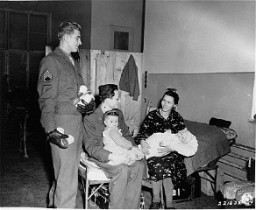
-
Eisenhower tours the Ohrdruf camp
PhotoDuring an official tour of the newly liberated Ohrdruf concentration camp, an Austrian Jewish survivor describes to General Dwight Eisenhower and the members of his entourage the use of the gallows in the camp. Among those pictured is Jules Grad, correspondent for the US Army newspaper Stars and Stripes (on the right). Ohrdruf, Germany, April 12, 1945.
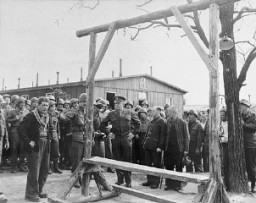
-
Liberated prisoners at the Ebensee camp
PhotoLiberated prisoners at the Ebensee camp. Too weak to eat solid food, they drink a thin soup prepared for them by the US Army. Photograph taken by US Army Signal Corps photographer J Malan Heslop. Austria, May 8, 1945.
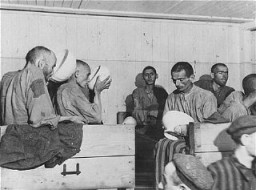
-
Nazi atrocities discovered upon the liberation of Buchenwald
FilmUS forces liberated the Buchenwald concentration camp on April 11, 1945. This footage records examples of Nazi atrocities (shrunken head, pieces of tattooed human skin, preserved skull and organs) discovered by the liberating troops.
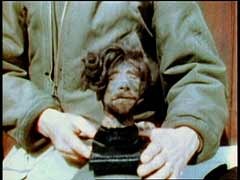
-
Chaplains inspect the liberated Buchenwald camp
PhotoDuring an inspection by US Army chaplains of the newly liberated Buchenwald concentration camp, G. Bromley Oxnam (right) views a demonstration of how prisoners were tortured in Buchenwald. Oxnam was the Methodist bishop of New York and President of the Federated Council of Churches of Christ in America. Buchenwald, Germany, April 27, 1945.
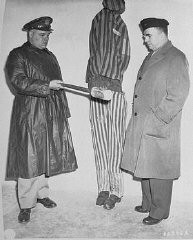
-
Liberated Soviet and Polish prisoners at Mauthausen
PhotoSoviet and Polish prisoners with disabilities stand in front of a tank of the 11th Armored Division, US Third Army. This photograph was taken at the Mauthausen concentration camp immediately after liberation. Austria, May 5–7, 1945.
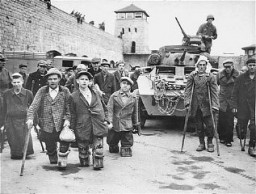
-
Survivors in Langenstein
PhotoSurvivors in Langenstein after the camp was liberated by the 83rd Infantry Division. Langenstein, Germany, April 17, 1945.
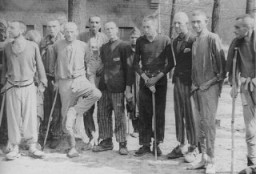
-
Mauthausen camp after liberation
PhotoMauthausen concentration camp inmates with American troops after the liberation of the camp.

-
A witness at the Mauthausen trial
PhotoA witness testifies during the Mauthausen concentration camp trial. The man standing in the background is defendant Willy Eckert, a member of the SS. The trial took place before an American Military Tribunal in Dachau, Germany. March-May 1936.
